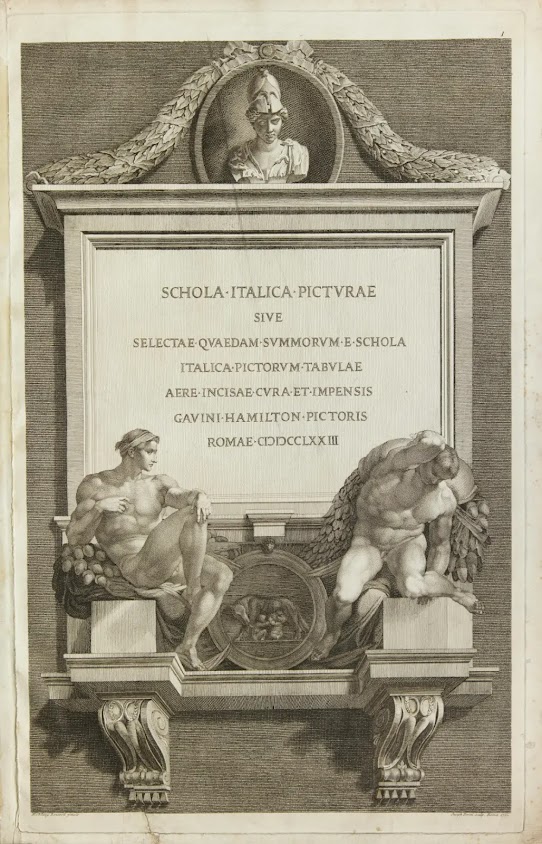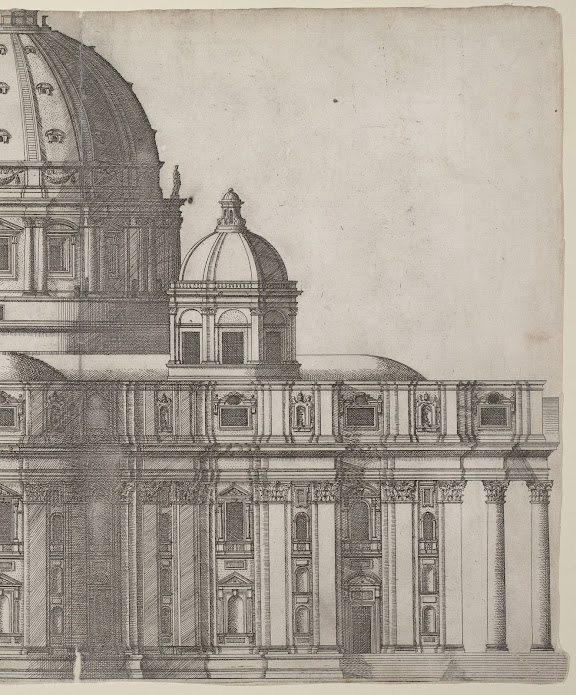Following the series on Michelangelo's works, this series features prints, mainly etchings and engravings made after his works. Many of them are contemporary to Michelangelo's own works, mostly 16th century and a few at the end of the series from the early 1800s.
Note: Many of the prints look similar to each other because they are copies of the same imagery, but most often at different dates.
This part 4 of a 4-part series on prints after Michelangelo
 |
| 1609-12 The Virgin of Pity engraving by Jacques Callot (France) 10.8 x 8 cm Louvre Museum, Paris |
 |
| before 1631 Moses etching & engraving attributed to Jacob Matham 36.3 x 24 cm Royal Academy of Arts, London |
 |
| 1633 David etching printed in black and white ink on grey-brown paper by François Perrier (France) 17.3 x 10 cm (sheet) Museum of Fine Arts, Boston, MA |
 |
| 1633 Bacchus etching by François Perrier (France) 17.1 x 9.1 cm (sheet) Museum of Fine Arts, Boston, MA |
 |
| before 1668 Rape of Ganymede etching by Coryn Boel (Netherlands) (size not given) Museum of Fine Arts, Boston, MA |
 |
| 1671 Sibyl etching & drypoint by Jan van Bisschop (Netherlands) 22.2 x 13.7 cm Museum of Fine Arts, Boston, MA |
 |
| 1700s-1803 The Prophet Daniel etching & engraving by Giovanni Volpato (Italy) 53 x 37.8 cm (plate) Detroit Institute of Arts, MI |
 |
| 1700s Noah's Altar by Angelo de Amgelis etching and burin on laid paper 22.8 x 27.4 cm Museum of Fine Arts, Orléans, France |
 |
| 1700s Holy Family with Saint John the Baptist design by Beaudoin etching/engraving on laid paper by Pierre Guillaume Beljambe 38.5 x 26.8 cm Museum of Fine Arts, Orléans, France |
 |
| 1726 Porta del Castel S. Angelo in Roma engraving and drypoint (plate) attibuted to Carl Hårleman (Sweden) 26.4 x 19.2 cm The Metropolitan Museum of Art, New York |
 |
| 1734 Raffle Ticket for the Painting of Venus and Cupid after Michelangelo etching by Giorgio Vasari (Italy) 35 x 22 cm (sheet) The Metropolitan Museum of Art, New York |
 |
| 1771 Schola Italica picturae etching & engraving by Giuseppe Perini 53 x 33 cm Royal Academy of Arts, London |
 |
| 1772 The Temptation and Expulsion from Eden, Sistine Chapel etching & engraving by Antonio Capellan 21.4 x 22.4 cm Royal Academy of Arts, London |
 |
| 1772 The Creation of Eve, Sistine Chapel etching & engraving by Antonio Capellan 21.5 x 27 cm Royal Academy of Arts, London |
 |
| 1772 The Creation of Adam, Sistine Chapel etching & engraving by Doenico Cunego 21.7 x 44.5 cm Royal Academy of Arts, London |
 |
| 1773 Young man asleep engraving by Adamo Scultori 14 x 10.2 cm Royal Academy of Arts, London |
 |
| 1789 Head of woman and other figures engraved by Corad Martin Metz 28.6 x 22.2 cm Royal Academy of Arts, London |
 |
| 1791-95 The Holy Family with the Baptist and other Saints drawn by Bozzolini Carlo, etching & engraving by Gaetano Cecchi 40.8 x 27.6 cm Royal Academy of Arts, London |
 |
| 1799 Leda and the Swan by Thomas Rowlandson (UK) etching and stipple, hand-coloured 16.6 x 22.2 cm The Metropolitan Museum of Art, New York |
 |
| 1800-1830 Head of a satyr, with pointed eyes and ears; a cutting from an unidentified book with letterpress on the back engraving on paper 12 x 88 cm © The Trustees of the British Museum, London |
 |
| c1800 The Erythraean Sibyl etching in colour by Tommaso Piroli 37.5 x 26.7 cm Royal Academy of Arts, London |
 |
| c1800 The Delphic Sibyl etching in colour by Tommaso Piroli 37.5 x 26.7 cm Royal Academy of Arts, London |
 |
| c1800 The Cunaean Sibyl etching in colour by Tommaso Piroli 37.5 x 26.7 cm Royal Academy of Arts, London |
 |
| c1800 The Persian Sibyl etching in colour by Tommaso Piroli 37.5 x 26.7 cm Royal Academy of Arts, London |
 |
| c1800 The Libyan Sibyl etching in colour by Tommaso Piroli 37.5 x 26.7 cm Royal Academy of Arts, London |
 |
| c1800 The Prophet Jeremiah etching in colour by Tommaso Piroli 37.5 x 26.7 cm Royal Academy of Arts, London |
 |
| c1800 The Prophet Isaiah etching in colour by Tommaso Piroli 37.5 x 26.7 cm Royal Academy of Arts, London |
 |
| c1800 The Prophet Daniel etching in colour by Tommaso Piroli 37.5 x 26.7 cm Royal Academy of Arts, London |
 |
| c1800 The Prophet Zechariah etching in colour by Tommaso Piroli 37.5 x 26.7 cm Royal Academy of Arts, London |
 |
| c1800 The Prophet Jonah etching in colour by Tommaso Piroli 37.5 x 26.7 cm Royal Academy of Arts, London |
 |
| c1800 The Prophet Joell etching in colour by Tommaso Piroli 37.5 x 26.7 cm Royal Academy of Arts, London |
 |
| before 1803 The Prophet Daniel etching & engraving by Stefano Tofanelli (Italy) 53 x 37.8 cm Detroit Institute of Arts, MI |
 |
| before 1808 Figure of an Old Man and a Head etching by Johann Theophilus Prestel (Germany) (size not given) Museum of Fine Arts, Boston, MA |
 |
| 1810 The Demon / The Lost Soul chiaroscuro woodcut by Agostino Gerli (Italy) 31.3 x 21.9 cm (sheet) Museum of Fine Arts, Boston, MA |
 |
| 1816 Evil engraving by William Sharp (England) 30.9 x 22.3 cm Art Institute of Chicago, IL |
 |
| 1875 Moses etching by Jules-Ferdinand Jacquemart (france) 23 x 16 cm (plate) The Metropolitan Museum of Art, New York |
 |
| n.d. Group from Last Judgment detail |
 |
| n.d. Group from Last Judgment detail |
 |
| n.d. Virgin and Child, man, two satyr heads, hands, dog (medium not given) 36.7 x 25 cm Louvre, Paris |
 |
| n.d. Study of one hand while drawing another pen and brown ink on paper 18.1 x 28.4 cm Louvre, Paris |
 |
| n.d. Group from Last Judgment, St. Bartholomew, St. Peter, and other Apostles engraving by Domenico del Barbiere (Italy) 37.5 x 22.5 cm (sheet) The Metropolitan Museum of Art, New York |







































